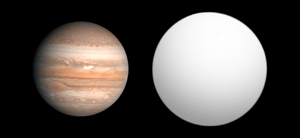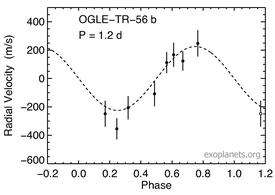OGLE-TR-56b
| Exoplanet | List of exoplanets | |
|---|---|---|
 | ||
| Parent star | ||
| Star | OGLE-TR-56 | |
| Constellation | Sagittarius | |
| Right ascension | (α) | 17h 56m 35.51s[1] |
| Declination | (δ) | –29° 32′ 21.2″[1] |
| Distance | ~4,900 ly (~1,500[2] pc) | |
| Spectral type | G? | |
| Orbital elements | ||
| Semi-major axis | (a) | 0.0225 ± 0.0004 AU (3.37 Gm) |
| Periastron | (q) | 0.0225 AU (3.37 Gm) |
| Apastron | (Q) | 0.0225 AU (3.37 Gm) |
| Eccentricity | (e) | 0 |
| Orbital period | (P) | 1.211909 ± 0.000001 d |
| (29.08582 h) | ||
| Orbital speed | (υ) | 203 km/s |
| Inclination | (i) | 78.8 ± 0.5° |
| Time of transit | (Tt) | 3936.598 ± 0.001 JD |
| Physical characteristics | ||
| Mass | (m) | 1.29 ± 0.12 MJ |
| Radius | (r) | 1.30 ± 0.05 RJ |
| Density | (ρ) | 779 kg m−3 |
| Surface gravity | (g) | 19.8 m/s² (2.02 g) |
| Temperature | (T) | ~1973 |
| Discovery information | ||
| Discovery date | 3 November 2002 confirmed: 4 January 2003 | |
| Discoverer(s) | Konacki et al.[3] | |
| Discovery method | Transit | |
| Other detection methods | Radial velocity | |
| Discovery status | Published[3] | |
| Database references | ||
| Extrasolar Planets Encyclopaedia | data | |
| SIMBAD | data | |
| Exoplanet Archive | data | |
| Open Exoplanet Catalogue | data | |
OGLE-TR-56b is an extrasolar planet located approximately 1500 parsecs away in the constellation of Sagittarius, orbiting the star OGLE-TR-56. This planet was discovered on November 3, 2002[1] by the OGLE project using the transit method and confirmed on January 4, 2003 by the Doppler technique.[2] The period of this confirmed planet was the shortest until the confirmed discovery of WASP-12b on April 1, 2008.[4] The short period and proximity of the OGLE-TR-56 b to its host mean it belongs to a class of objects known as hot Jupiters.

The radial velocity trend of OGLE-TR-56, caused by the presence of OGLE-TR-56 b.
The planet is theorized to have iron rain.[5]
See also
References
- 1 2 3 Udalski, A.; et al. (2002). "The Optical Gravitational Lensing Experiment. Search for Planetary and Low-Luminosity Object Transits in the Galactic Disk. Results of 2001 Campaign - Supplement". Acta Astronomica. 52 (2): 115–128. arXiv:astro-ph/0207133
 . Bibcode:2002AcA....52..115U.
. Bibcode:2002AcA....52..115U. - 1 2 Konacki, Maciej; et al. (2003). "High-Resolution Spectroscopic Follow-up of OGLE Planetary Transit Candidates in the Galactic Bulge: Two Possible Jupiter-Mass Planets and Two Blends". The Astrophysical Journal. 597 (2): 1076–1091. arXiv:astro-ph/0306542
 . Bibcode:2003ApJ...597.1076K. doi:10.1086/378561.
. Bibcode:2003ApJ...597.1076K. doi:10.1086/378561. - 1 2 Konacki, Maciej; et al. (2003). "An extrasolar planet that transits the disk of its parent star" (PDF). Nature. 421 (6922): 507–509. Bibcode:2003Natur.421..507K. doi:10.1038/nature01379. PMID 12556885.
- ↑ Hebb, L.; et al. (2009). "WASP-12b: THE HOTTEST TRANSITING EXTRASOLAR PLANET YET DISCOVERED". The Astrophysical Journal. 693 (2): 1920–1928. arXiv:0812.3240
 . Bibcode:2009ApJ...693.1920H. doi:10.1088/0004-637X/693/2/1920.
. Bibcode:2009ApJ...693.1920H. doi:10.1088/0004-637X/693/2/1920. - ↑ Harvard University and Smithsonian Institution (2003-01-08). "New World of Iron Rain". Astrobiology Magazine. Retrieved 2010-01-25.
External links
![]() Media related to OGLE-TR-56 b at Wikimedia Commons
Media related to OGLE-TR-56 b at Wikimedia Commons
- "OGLE-TR-56 b". Exoplanets. Retrieved 2010-01-21.
Coordinates: ![]() 17h 56m 35.51s, −29° 32′ 21.2″
17h 56m 35.51s, −29° 32′ 21.2″
This article is issued from Wikipedia - version of the 8/11/2016. The text is available under the Creative Commons Attribution/Share Alike but additional terms may apply for the media files.